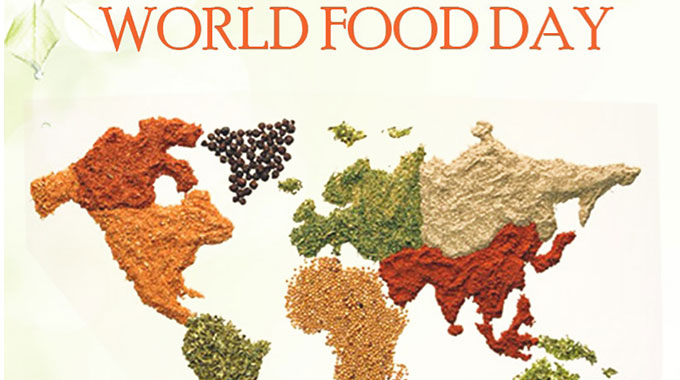World Food Day — encouraging healthy diets for a #ZeroHunger World

Andile Tshuma
More than two million people are in need of food aid in Zimbabwe this year.
With the soaring prices of seed maize, analysts fear that some households might be unable to purchase it. In the circumstances, more people will pin hopes on the Presidential input scheme for their farming inputs for the 2019/20 season.
Apart from the expensive seed, climate change is also threatening yields. Although normal to above normal rains have been predicted for the first half of the farming season, Agritex officials say the second half is likely to be relatively dry.
Experts have called for the adoption of drought tolerant crops as mitigatory measures for these erratic rainfall patterns, but most people seem to be struggling to adopt them.
In Zimbabwe a lot of crops that were cultivated 50 years ago, including small grains such as rapoko, sorghum and millet are not known by some people today.
However, many people lack the knowledge, resources or motivation to eat healthy diets.
As times are really hard for the generality of Zimbabweans, meal planning is often a nightmare and often, many households are just eating what is available and what makes economic sense. Less effort is put towards ensuring that families consume a healthy and balanced diet.
Food diversity is reducing, which means that the food supply is more vulnerable to climate change, and environmental damage from farming animals for meat and dairy is increasing.
According to the United Nations Food and Agriculture Organisation (FAO) there are now more people in the world who are obese than are malnourished. Unhealthy diets and sedentary lifestyles are now the biggest risk factor for disability and death worldwide.
Changing young minds is important in promoting healthy diets as food habits and preferences are established early in life, so it’s vital that children are encouraged to eat healthily.
In recent decades, people have dramatically changed diets and eating habits as a result of globalisation, urbanisation and ever changing incomes.
The majority of the people in Zimbabwe, especially in urban settings, have moved from seasonal, mainly plant-based and fibre-rich dishes to diets that are high in refined starches, sugar, fats, salt, processed foods, meat and other animal-source products. Less time is spent preparing meals at home, and consumers, especially in urban areas, increasingly rely on supermarkets, fast food outlets, street food vendors and take-away restaurants.
The World Health Organisation states that a combination of unhealthy diets and sedentary lifestyles has sent obesity rates soaring, not only in developed countries, but also low-income countries, where hunger and obesity often coexist. Now over 670 million adults and 120 million girls and boys (five to 19 years) are obese, and over 40 million children under five are overweight, while over 820 million people suffer from hunger.
An unhealthy diet is the leading risk factor for deaths from non-communicable diseases (NCDs), including cardiovascular diseases, diabetes and certain cancers. Linked with one fifth of deaths worldwide, unhealthy eating habits are also taking a toll on national health budgets costing up to US$2 trillion per year.
Obesity and other forms of malnutrition affect nearly one in three people globally. Projections indicate that the number will be one in two by 2025. The good news is that affordable solutions exist to reduce all forms of malnutrition, but they require greater global commitment and action.
Nutritious foods that constitute a healthy diet are not available or affordable for many people.
Healthy diets are threatened by a number of factors, which also include climate change, which will reduce not only the quantity of crops but also the quality and nutritious value of the yield.
It then becomes even more important for people to make an effort to eat a variety of foods to try and get as much nutrients as possible.
According to FAO, of some 6 000 plant species that have been cultivated for food throughout human history, today only eight of them supply more than 50 percent of our daily calories, which is really worrying.
In the way our food systems currently work, from agricultural production to processing and retailing, there is little space for fresh, locally produced foods as staple crops such as cereals take priority.
Intensified food production, combined with climate change, is causing a rapid loss of biodiversity. Today only nine plant species account for 66% of total crop production despite the fact that throughout history, more than 6 000 species have been cultivated for food. A diverse variety of crops is crucial for providing healthy diets and safeguarding the environment.
Shifting to a healthier diet by eating more seasonal fruits and vegetables and reducing the consumption of junk food could help in meeting the ‘zero hunger’ goal of the UN-mandated Sustainable Development Goals.
Over 820 million people, approximately one in nine people around the world, are hungry, and malnutrition affected one in every three people, according to FAO.
Many countries are battling a crisis of extremes, with many affected by obesity and others by food insecurity.
A significant number of people globally are suffering from food insecurity, a situation in which people lack secure access to sufficient amounts of safe and nutritious food for normal growth and development and an active and healthy life.
Over 30 000 edible plant species are known to humanity, out of which, only 200 are cultivated at the farm level, the eight major crops namely wheat, maize, rice, barley, beans, groundnut, maize, potatoes, and sorghum.
Governments and organisations must work harder to ensure that people grow more food, wider varieties and that the vulnerable are protected and that nobody goes hungry. There should always be enough to go around. — @andile_tshuma











Comments